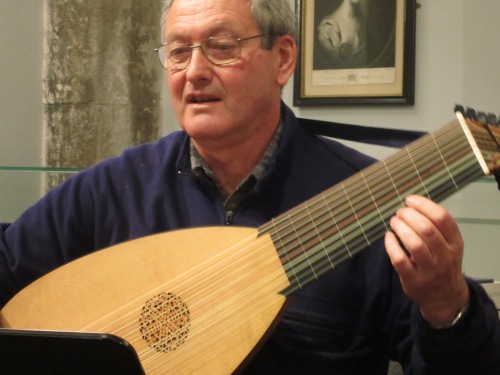Review of 8th Meeting – 12th October 2013
A smaller turnout than usual, but with a few notes of absence from members who are away at the moment. Big welcomes, though, to two new members: Annie Pia and Reyyan Khawlah Özer!
Another surprise was the absence of any lutes or guitars in the museum’s collection. They had all been put into storage to make way for a wonderful bagpipe exhibition.
We started with an hour of playing. There then followed a discussion about the future of the society.
Philip Lord got the performance part of the afternoon underway, with three pieces on his Paul Thomson vihuela, only one of which was a Spanish piece. I for one don’t mind hearing 6c lute repertoire on its Spanish cousin.
First we had Sellinger’s Round [from a manuscript in Trinity College, Dublin (MS 408/2) published by the Lute Society 1999] which was well played, the vihuela’s round, warm voice providing a welcome and soothing antidote to the Edinburgh traffic outside.
There followed two versions of the so-called Toy – from the Jane Pickering Lute Book – one slow, and one fast.
Philip signed off with a performance of Fantasia No. 1 – from Luis Milan’s El Maestro, 1536. Although one of Milan’s easier pieces, it is far from easy, but Philip coped reasonably well with its intricacies. It would be nice to hear more vihuela music from him in the future.
Bill Samson played next, the difficult Pavana a la Ferrarese by Joanambrosio Dalza. It’s not easy on a 6c lute, and less so on a 10c, although this one was Bill’s home made (in the best sense) 10c lute, which despite being new revealed some beautiful, sparkling trebles. Well done, Bill, both for the lute and the performance.
Another Bill Samson lute was next heard in the hands of Rob MacKillop, who prefaced his performace with a little information on the Scottish “port”, pronounced porscht, which is attached to a number of pieces in the Straloch manuscript. Port refers to an air or tune which is not a dance. Rob then gave a committed performance of A Port and Port Jean Linsay, from Straloch. Everyone was in agreement that the lute sounded lovely.
Graham Wylie was up next, playing music by Nicolas Vallet and Robert Ballard on a 10c/11c lute by Martin Shepherd. Graham gave an interesting foreword, before playing a piece which to this reviewer’s lugs sounded very much like a piece in the Rowallan manuscript. This should be no surprise, as trade was rich between the two countries at this time, and a couple of Dutch pieces can be found in Scottish manuscripts. It was nice to hear Graham perform this – not easy – music.
Then we had a short but very beautiful performance on Baglama Saz by Reyyan Khawlah Özer, a student at the university, who had just had her second lesson in saz playing from another university student. It was wonderful to see Reyyan, and everyone seemed very interested in the saz and Turkish music in general. The saz is very much a minority instrument in Scotland (!) so it is only right that the Scottish Lute and Early Guitar Society should provide support to Reyann in her studies, and I hope we can hear from her again at the next meeting – which should be in January: watch this space.
The discussion which followed touched on many subjects, not least the character of the society, and would that change if we opened up to other instruments in order to build up a membership. There seemed to be a general feeling that the present membership valued the small scale, intimate and supportive meetings, and feared that that might be compromised in a drive to attract other musicians. There was no great plan of action decided upon, so business will be as usual. We are, however, on the hunt for speakers. If you have a topic you’d like to present at a future meeting, please contact Bill Samson [billsamson at hotmail.co.uk] or Philip Lord [Philip at philiplord.net].
Photos by Bill Samson, other than the photos of Bill Samson, which are by Rob MacKillop, as is the photo of Philip Lord 🙂
Philip Lord:

Rob MacKillop:

Graham Wylie:

Reyyan Khawlah Özer:

Rob MacKillop:


Leave a Reply